overview & itinerary
Some of our highlights:
- Rainforest trekking far off the beaten tracks discoveries in the deep rainforest
- Visiting native tribes and congregate with them
- Exploring the big, medium, small, and smaller rivers; silent canoe rides on igarapés
and tributaries - Wildlife observation
- Introduction to the Amazonian rainforest flora and the planets greatest biodiversity
- Survival technics
Expedition Itinerary
Day 1
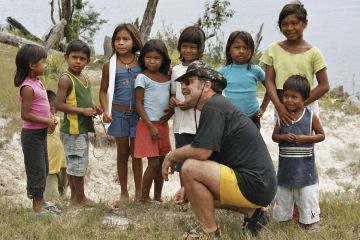
Arrival at São Gabriel da Cachoeira. Pick-up and presentation to guides. We need to get the permit to visit Indian territory and reservations before we board our motorized dog-out canoe. Masterfully steered by our guides, we pass the strong currents and treacherous rapids near São Gabriel da Cachoeira. After roughly 2 hours of traveling on the Rio Negro downstream we reach the Indian settlement São Jorge located at the mouth of the Rio Curicuriari. We will be welcomed by the tribe members of the linguistic group of the Tukano. After introductions and handing over of a gift to the "captain", how the chief is called here, we will be shown around the village. After the short stay at São Jorge we will continue our journey now upstream Rio Curicuriari reaching after 3 hours Camp 1, the Tumbiara Indian village. While traveling on the river we would stop for foto shooting and observations of fauna and flora of the rainforest. Since you will be tired from the trip you will enjoy your first dinner and hammock overnight in the rainforest.
Day 2

The Indian comunities on the upper Rio Negro bassin are organized and coordinated by ACIBRN, where members of the tribes decide issues of common interest, making sure that traditions and values are maintained and civil rights to which the tribes are entitled being respected.
As in the old days, before they were "civilized" by catholic missionaries in the late 18th century, natives of the region still use hand-made tools in their everyday lives, e.g. manioc grinders and shakers. Manioc and fish provides most of the diet of the Tukano people, although they also plant bananas and harvest Brazil nuts to trade for beans, rice and medical supplies. The traditional buildings here are made from sticks and clay with wild açaí palm leaf thatched roofs, held together with cipó vines. The tribe members usually are physically healthy and in good shape. The Tumbiara village looks neat, well organised and structured.
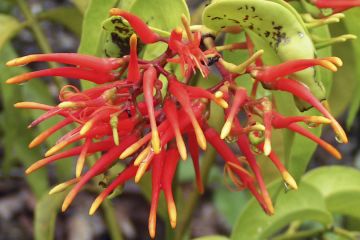
After breakfast we will take the canoe to discover hidden secrets of the igarapé, how the temporily flooded areas are called. These smaller rivers and their surroundings are home to wildlife including Giant otters, Anakondas, and a variety of monkeys. With the help of ur guides we are going to catch delicious fish for lunch. If lucky we get tucunaré or tambaqui on the hook. After lunch and siesta the forest invites for a stroll.
The overwhelming plantlife includes millions of species many of them still unknown to science. Our guides identify for you medical plants of the Amazon without them modern medicine would not be possible.
It is time now to take the canoe for our ride back to the village, where the guides prepare dinner at the open fireplace. The day was long and full of action, but the hammocks are ready for you and the sounds of the jungle eases you into sleep.
Day 3
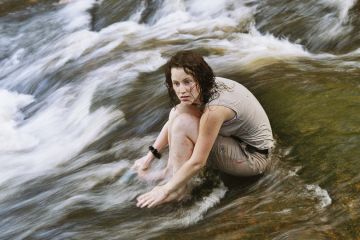
After our jungle breakfast we drive downstream Rio Curicuriari until we reach the trail leading to the clay lick “paredão das araras”. An about 3 hours ride carries us to the Rio Cariuá where we pitch our camp near the Piranhauara waterfall. Here, a resfreshing bath is what we want. Besides, the lush area around the waterfall offers plenty opportunities for taking great pictures. From here we hike the old trail used by the natives to carry huge quantities of Piaçaba thatch extracted from Attalea funifera and Leopoldinia piassaba palms and exported to all parts of Brazil. Our guides show us how this thatch was harvested and taken to the river. The will also show us how to buid a shelter from palm leafs in a fraction of time. Back at the camp we relax in our hammocks while the guides prepared the dinner. With the fire still burning we chat about our first impressions in this amazing and unknown environment called Amazonia.
Day 4
Hike to macaws and parrots clay lick
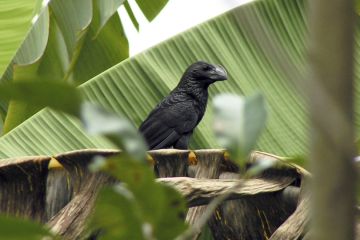
The hikers among us have the saying today. The destination is the parrots and macaws clay lick, requiring a jungle hike of some 8 hours. During regular breaks we observe the area around us and watch how the guides extract fresh water from lianas or identify medical plants like quinine, xixuá Maytenus Guyanensis Klotzch a biotonic and estimulant or Copaiba oil Copaifera sp., a powerful antibiotic.
We learn about the Amazonian rainforest and will respect this unique environment as an inexaustible provider of medicine. Our camp is pitched near the clay lick. The long hike takes certainly its toll and after the hungry mouth are plugged everybody hits the hammocks with relief.
Day 5
Macaws and parrots clay lick - Paradeão das Araras
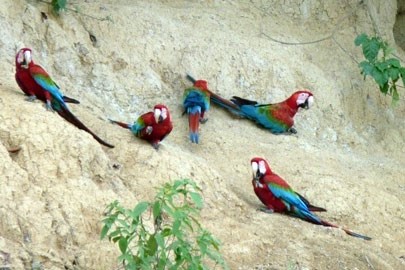
Our guide Alberto discovered the clay wall on one of his jungle explorations. Hidden in the dense forest ony a few natives know its location. There is plenty of time to watch and photograph several species of parrots and the colourful macaws like the yellow-breasted Ara ararauna and green-winged Ara chloroptera when they supply their need for minerals at the wall, otherwise not available in the forest. The constant arrival and departure of the birds provides a lively and colorful spectacle. Since today´s digital cameras offer no or little limit you may click away to choose the best shots for your photo album of memories when back home. Return o the camp for overnight.
Day 6
Expedition, Camp Arabú (Lage)

After breakfast we break down the camp and take the trail back to Cariuá Igarapé, where we anchored our canoe. We travel the Cariuá downstream to enter the Curicuriari river taking us to the starting point of the trail leading to the Bela Adormecida or “Sleeping Beauty” hill.
At Arabu igarapé a small waterfall invites for a refreshing shower. This is also the ideal place for our camp for the night. At camp site our guides prepare a drink from saracura mirá roots (Ampelozizyphus amazonicus Ducke) that cleanses all the organs in the body and isalso used to relief chest pains. It is also recommended against malaria. This is a quite a lengthy process which begins with scraping the shavings of roots into a pan, adding water and whisking vigorously with a split root that replaces the whirl, until it foams. After this the foam is scraped off before repeating the method another four times and then drinking the mixture which has a bitter taste, but improves the more you drink! The guides who carry all the equipment and food all the way in their yamanchis, the natives pack-pack, vow for the drink as it relieves their chest pain. After dinner we set out for a night walk into the forest. With the help of our flash lights we watch night life in the jungle including nocturnal animals. Since the jaguar is also a nocturnal hunter the hope is not to have a close encounter with this magnificent cat.
Day 7
Expedition, Trail to Sleeping Beauty hill
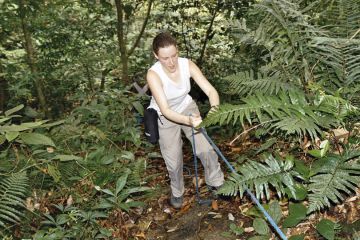
A 4 hours hike through dense rainforest takes us to the foothills of the “Sleeping Beauty”, where we mount our camp. The mountain's contoures resemble those of a sleeping woman, hence its name.
For the rest of the day we explore the area around the camp and with the help of our knowledgable guides trying to identify some of the plantlife around us. Epiphytes like bromeliads and orchids, endemic to the region, will catch our attention. To the interested nature photographer they are most attractive especially when in flower. Perhaps you discover the chocolate scented Braemia vittata which opens its bulb beginning of November, or you may marvel at the yellow Octomeria grandi-flora unfolding its colors in short intervals between end February and beginning of March. As tomorrows hike to the peak of “Sleeping Beauty” requires to be in good shape early and a good amount of sleep is recommended. Not before however, we have enjoyed our jungle dinner our guides have cooked for us.
Day 8
Ascent to the top of the Sleeping Beauty
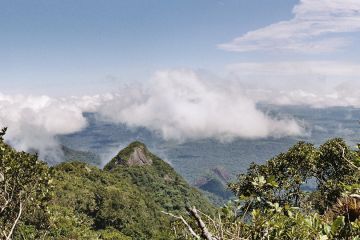
This morning we are heading for the top of the "Sleeping Beauty”. After approximately 4 hours exhausting uphill hike the group arrives at the ridge of the mountain. Time to take a breath and get prepared for a short climb to the summit. While this climb does not require technical expertise in mountaineering a rope is needed to support your efforts to get to the top. The views from here are breathtaking, with the Amazonian rainforest stretched out below us like a blanket. At 1,125 m above sea level, we can identify some of the places we have passed by so far, including São Gabriel da Cachoeira, the port of Camanaus, the Rio Negro and the Curicuriari as well as the São Jorge community. We stay on the summit for a good while, enjoying amazing vistas with great photo opportunities.
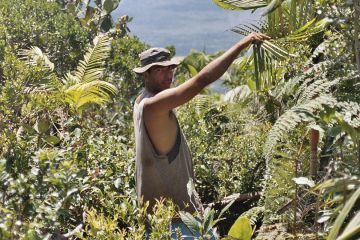
The descent is much tougher on the knees than ascending. We safely negotiate the obstacles in our way back to the camp (e. g. the vertical sections, hornets nests and snakes like the non poisonous smooth machete savanne or Rusty whip snake, here called cobra cipó, which is common in the primary Amazonian forest). Back at the camp we are ready for nothing else except for a delicious meal that has been cooked to perfection while we have been away, followed by a crawl into our hammocks to rest up after a full day of exertion. The "Sleeping Beauty" of the Amazon is (in our opinion) one of the best daylong ascents/descents trekking to be found anywhere and is a must see for non-technical mountaineers and hikers alike.
Day 9
Expedition, Return to Igarapé Lage

Our trekking today brings us back to the Igarape lage, where we moored our canoe. On route we marvel at giant buttress root kapok trees Ceiba petandra in Brazil called Samauma, that can reach up to 200 ft high. This last night in the forest we will stay at the tukano village of São Jorge. Depending on the remaining fuel, the expedition leader might take the canoe to a nearby port and pick up a few well-earned cold beers to enjoy on our last night in the jungle. We have arranged for a good bye party with the natives during which they will present us with traditional dances of the tribe. After stories around fire place, the party settle down to their last night in hammocks – that king size back home seems a long way away and you wonder if you'll ever get used to it again?...the traffic… closing times at the pubs... perhaps I'll just stay a while longer...
Day 10
Return São Jorge community - São Gabriel da Cachoeira
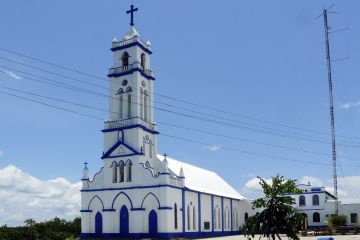
Packing up the gear and saying good bye to our Tucano friends is on the plan today. We arrive back in São Gabriel da Cachoeira before lunch time and check-in the “Deus me deu” hotel. There will be a hot shower waiting for you, if that is what you long for. Use the afternoon to get your baggage cleaned and prepared for the flight to Manaus and further. I also recommend a stroll through the border town and visit to the FOIRN community centre where you can purchase beautiful handicraft from yanomami and other tribes of the upper Rio Negro basin. A last dinner with your guides at a local Restaurant with some caipirinhas to go along will certainly contribute to forget the “hardships” of the past 10 days only to remember awesome experiences and fun in the Amazonian rainforest.
Day 11
We will transfer you to the airport to catch the flight to Manaus. This is the end of our services for the Rio Negro Rainforest Experience. If you wish to book one of our other activities in Brazil or need our help otherwise, please let us know. We will be pleased to assist you.
travelogue
Expedition Travelogue
"The Amazon region - mosquitoes notwithstanding - is one vast paradise."
Spanish Jesuit Cristóbal de Acuña in "A New Discovery of the Great Rivers of the Amazon", 1641
Day one: Into the forest
An early start to this tour (0630h). The clients and expedition leader enjoy a hearty breakfast at the Hotel Waupés in São Gabriel da Cachoeira before loading all the equipment into the canoe fitted with a 40 hp outboard motor, that is waiting for us on the sandy beach on the Rio Negro. When all the kit is accounted for, we set off at 0800h. Even at this hour the sun is beating down on Amazônia, creating a beautiful setting in which to begin the expedition. After 15 minutes we reach the quaint port of Camanaus where the guides stop the canoe in order to load fuel drums and pick up some fresh bananas while Peter, Tristan and the clients visit one of the ships that has recently arrived from Manaus. This three-day trip departs every Friday, and provides an alternative to the Rico flight that we arrived on a few days previously.
Back on board and we continue downstream on the Rio Negro – fresh, very small but sweet bananas fuelling our bodies. One can feel the sense of anticipation and excitement about the impending trip as we continue to sítio Jeremias (Jeremias' smallholding on the river) where we literally get our first taste of what is in store! Here we sample some of the delicious jungle fruits that can be found in the area for example: fresh coconut water, Cayenne lime (which tastes like a gooseberry) and guava. It is here that our guides pick up some extra hammocks for the clients and essential tools in case of emergencies with the outboard motor on the canoe.
After 45 minutes, everyone re-boards the canoe and we continue to the mouth of the Rio Curicuriari. We moor the boat at a tukano Indian village, as we have to impart sad news that the chief's son had died in the city. Despite the morbid nature of our visit, the locals (especially the children) are intrigued and pleased by our visit that provides excellent photographic opportunities of Peter with the local children. It is getting towards the hottest part of the day now and so Peter, Tristan and Jeremais take advantage of the refreshing waters and take a quick swim before continuing our voyage on the Rio Curicuriari to a beautiful waterfall, the location of which is also the start point of the on foot expedition on day two.
The waterfall provides another excellent bathing opportunity, although one has to be wary of the strong currents of the river to avoid being swept away. After this relaxation, Aldair leads us on a brief discovery tour in the jungle (giving our clients an taster before beginning outright on day two). On our return, Jeremias and Alberto have prepared a picnic of tuna, bread and a type of hot local spicy sausage (like chorizo) cooked on a fire, all washed down by ice cold Coca-Cola from the ice box.
After lunch we get back on the canoe and a short trip (10 minutes) back upstream leads us to our destination for day one. We arrive at 1500h at another small village of the Tukano Indian tribe called São Jorge, where we receive a warm welcome from the chief (here called capitão) and villagers alike. An association called ACIBRN organizes this community, together with three others of the lower Rio Negro basin. The association has the purpose of maintaining traditions, values and customs combined with promoting awareness of the civil rights to which all Indians are entitled. As in the old days, before they were "civilised" by catholic missionaries in the late 18th century, they still use hand made tools in their everyday lives, e.g. manioc grinders and shakers. Manioc and fish in a great variety of forms provides the vast majority of the diet of the Tukano people, although they also plant bananas to trade for beans and medical supplies. The traditional buildings here are made from sticks and clay with wild açaí palm leaf thatched roofs, held together with cipó vines. They look very strong and in all, the place looks neat, very organised and well structured.
We are shown to the community hut where we participate in an enlightening church service (the main religion here is Catholicism) that coincides with our first rains before stringing our hammocks in the same building. Not long after this experience we are called for supper that has been prepared by the guides on a fire and includes steak skewers, rice, and pasta dishes, all tastes and dietary requirements are catered for on Southern Cross tours (including vegetarian dishes for Corinne, our vegetarian client). Not long after dinner we all retire to our hammocks for our first night in the bush, and for our clients, their first night sleeping in a hammock.
Day two: The first trail
Another early start (0600h) as we are awoken by the village priest banging on a tin, calling the villagers to morning prayers and their breakfast of porridge made from manioc. The Southern Cross party enjoys a nutritious breakfast of muesli, toast and jam, coffee and English tea for Tristan (nicknamed "The Jungle Boy" by Peter and the guides, and new addition to the Southern Cross team). After breakfast we return to the canoe, watching the villagers removing a tree stump from deep in the sandy ground in order to create space for a new school, and we set off at 0845h for the waterfall we visited on the previous day. En route we deposit equipment (tents, roll mats and the 70 litre ice box) and supplies that we will not need at an abandoned manioc plantation ready to collect after our trail in the jungle. At the waterfall the guides secure the boat on the riverside and hide the engine and fuel drums in thick bush to collect on our return. On the completion of these essential tasks we begin on our trail through the bush.
Within minutes we begin to see evidence of wildlife. The first sight we encounter is the swinging trees high in the forest canopy, a tell-tale sign of the presence of monkeys, but despite our best efforts they were already gone before we could catch a glimpse of them, as if toying with the wishes of the clients to see them! However, our spirits are not dampened too much and our patience is rewarded as we continue on the trail when see a forest chicken (inhambú) fly off a branch for five metres before disappearing in the thick cover of the forest floor. A whole group of wild pigs took off with lots of noise when we approached them unexpectedly. Also on the trail we see (and feel!) leaf-cutting soldier ants in there thousands carrying away the forest with regimented order, as well as the nest of the flying ants (saiuva, that grow to three centimetres long). Peter tells us the story of how they use these biting insects as a test of bravery for boys in the tribes – they put the saiuva in analgesic jelly in a glove and the youngster then puts the glove on his hand. As the anaesthetic wears off the ants bite the boy and the elders watch his face for signs showing pain (perceived as weakness), and depending on how much pain he shows, he is accepted (or not) into adulthood and a valued member of the tribe.
We are walking through pristine terra firme forest (one of three basic types of the Amazonian rainforest), which remains unflooded throughout the year and therefore allows easy access. The two other main types: the igapó forests, which are permanently flooded and allow only canoe access where you navigate on a level with the tree canopy. The other type of forest, the várzea forest, grows in the region of white water Rivers, which is partly and seasonally flooded (between May and the end of September). It is the terre firme forest where you find the largest trees and we see huge trees up to 60 metres tall and needing at least 10 people to span the circumference while holding hands!
After two hours trail – taking time to admire the dense forest all round us, wading through leaves, mud, stepping over huge roots, and safely negotiating river crossings we arrive at some rapids (igarapé) on the fast flowing stream called Arabu (which flows all the way from Bela Adormecida to feed the Rio Curicuriari). The rapids provide an excellent bathing opportunity for all except the guides, who, reading the darks skies, hastily set about restructuring an existing shelter in order to accommodate everybody comfortably. In the middle of the construction process, the heavens opened with torrential rain and a cover was hurriedly put over the shelter in order to protect the equipment and food we had with us. As the rains subside, the hammocks are strung whilst the guides begin preparing a fire to cook the dinner (chicken, rice, bean stew, sausage). A second heavy rainfall prevents any afternoon discoveries for the clients and so Peter fixes an exotic batida with schnapps and fruit juice whilst he and Tristan build another fire at the other end of the camp to generate some smoke to keep the mosquitoes at bay (at the same time making the team's eyes water!). Darkness descends on the jungle by 1900h hand the clients retire to hammocks after dinner around 2000h, whilst Peter and Tristan keep the fire going, at the same time enjoying the luxury of a nice cup of Yorkshire tea, brought along all the way from England by Tristan!
Day three: Back on the trail
Awake at 0600 hrs with yet more rainfall, making our guides jump out of their hammocks to find cover under our shelter! We set off on the trail at 0845hrs after the usual delicious jungle breakfast, beginning with a river crossing over the igarapé. Once more the trail reveals numerous flora and fauna, all of which seem to have a purpose. Aldair imparts much of his indigenous knowledge, which has taken thousands of years to accumulate, to the party (excellently translated by Peter to ensure everyone gains this benefit). For example, we come across a fallen açaí brava palm – the roots of which are mixed with water and used to treat malaria. We also come across the buds of orchids not yet in flower (yet still beautiful) and numerous fruits and nuts lying on the forest floor.
After a three-hour hike through dense forest we arrive at the base of Bela Adormecida (literally means "Sleeping Beauty", the name given due to its unusual horizontal feminine shape!). Here we come across the Arabu River once more, providing delightful pools for bathing surrounded by huge boulders covered in rich green liche and mosses. Peter and the clients take advantage of this fairytale setting (Peter even finds a flake of gold in one of the pools), whilst Tristan helps the guides build another shelter, collecting cipó (tough, string-like vines that are used to bind the struts of the construction together). In the afternoon the clients set off with Alberto on a jungle discovery walk that provides them with excellent photographic opportunities of the varied flora and fauna of the Northern Amazon region. Peter and Tristan remain at the base camp, where Peter briefs Tristan in preparation for tomorrow's ascent on Sleeping Beauty, as he will be remaining at base camp.
The camp looks great, very professional indeed - there is even a mug tree! The guides have put covers over their hammocks after last night's rains and everything is very ordered ready for the return of our clients. Peter and Tristan have constructed an excellent fire (to rival that of the guides!) by which we attempt to smoke our clothes dry!
As darkness descends on the jungle at 1830h the cacophony of noise is ever present. The call of the Inhambú is most prevalent however we hear other calls as well, for example armies of frogs and toucans (Toucana). The guides strategically place candles around the camp as dinner time approaches and the whole place gives off an eerie sense of seclusion, the perfect place for quiet contemplation away from the stresses and strains of hectic western lives. Everyone enjoys a large dinner of steaks, stews and pasta dishes, then an early night ready for the climb on day four.
Day four: Conquering "Sleeping Beauty"
Reveille at 0600h after the coolest night we have experienced so far (relatively), all the party had put on their lightweight fleeces during the night to stave off the chill of the night air. After a quick breakfast Tristan, Alberto, Jeremias and the clients begin their ascent at 0715h. The uphill battle is unrelenting with very few flat areas however, we make excellent progress - Alberto all the while marking our route with his machete on trees to ensure a safe descent with minimal forest disturbance. After two hours of steep uphill we arrive at a small canyon where we take a break and collect fresh, cool water from a spring coming out of the mountainside. After ten minutes we begin our ascent again, scrambling over moss covered boulders (some of which were bigger than Tristan standing at 175 cm!). As we gain altitude the wind begins to pick up and the clouds descend around us as we continue to climb. We soon reach a near vertical 13 m section with no tree roots or cipó to use as grabs, and so we have to rope up to ascend further. As we reach the top of this section we catch a glimpse of our target, unfortunately the group lacks the necessary climbing expertise to ascend the rock face with orchids springing from it - as if from nowhere - so we wind our way around it as we continue still higher. Once more we reach another near vertical section (more difficult than the last both in terms of gradient and length – 20 m) as the summit is within our grasp. At this difficult obstacle we marvel as Alberto (in his 50 s) scrambles up a decaying rope (that looks as if it has been there for over 30 years) in order to throw down a new line. Tristan ascends the rope first and establishes its stability before Jeremias harnesses the clients in and they are aided up the section. Once everyone has safely negotiated the rope we continue the final 30 m of thick bush, as if no one has been here for 20 years – to the summit of Bela Adormecida. (Arrive 1115h.)
The views from the top are breathtaking, with the Amazonian rainforest stretched out like blanket below us. At 1,125 m above sea level (900 m climb from base camp) we can see many of the places we have visited so far including São Gabriel da Cachoeira, the port of Camanaus, the Rio Negro and the Curicuriari as well as the São Jorge community. Tristan even strives to see the waterfall where we moored the canoe, but from this vast distance it is wishful thinking! We stay on the summit for one hour, enjoying the beautiful vistas that provide spectacular photo opportunities and a delightful lunch spot among the delicate crystal white orchids and the singing birds, not to mention our first sight of the sun since entering the jungle!
After lunch Tristan erects a jungle flag (a stick and a leaf) to mark the party's conquering presence, before beginning our descent at 1215h. The descent is much tougher on the knees than ascending and that makeshift abseiling is definitely for the more strong hearted and adventurous people. We safely negotiate the obstacles in our way (e.g. the vertical sections, hornets nests and snakes – cobra cipó) before arriving at camp at 1515h where we are greeted by Peter and Aldair who have been busying themselves preparing sardine salads and making drying racks for clothes (Peter has also been keeping the fire alive). Here we take the opportunity to relax in the bathing pools before returning to camp to enjoy Peter's delicious meal; after which the clients hit their hammocks to rest up after a full day of exertion. The "Sleeping Beauty" of the Amazon is (in my opinion) one of the best day-long ascents/descents to be found anywhere in the world and is a must see for non-technical and more advanced mountaineers alike.
Day five: In search of precious aquamarine
Awake at 0600h to find the fire still going! After a leisurely morning, taking breakfast at 0745h, we set off without packs with Alberto and Jeremias for an abandoned blue aquamarine mine. On the way we see (once more) flora and fauna that usually one only reads about including grape-like vines on the forest floor, the giant Brazil nut trees (Sp. Bertholletia exelsa) and the famous rubber trees (Sp. Hevea brasiliensis). The history of the rubber tree in Brazil is rich and is worth mentioning here.
The Omagua Indians discovered the properties of rubber in the 18th century. However, it was Charles Goodyear's 1844 discovery of vulcanisation and the development of the pneumatic tyre in 1888 that caused a commercial explosion. The price of rubber soared and, in 1897, rubber tapers (seringueiros) in Brazil produced 21.000 metric tonnes of 'black gold' and sold 88 per cent of all exported rubber in the world, thus creating an extravagant monopoly and turning the port city of Manaus into one of the richest cities in the world by the turn of the 20th century thanks to the "Rubber Barons". The story however is not all sweetness and light as English botanist Henry Wickham (1876) loaded 70 000 Hevea brasiliensis seeds onto a steamer and smuggled them out of Brazil (under the pretence that they were rare plant samples for Queen Victoria) and planted them in British controlled plantations in Malaysia where they were flourishing by 1912. This allowed Brazilian prices to be undercut just before World War One, and within a decade Manaus was once more a jungle backwater city. The American industrialist Henry Ford (inventor of mass production) attempted to compete with the British by setting up his own Amazon plantations (at Fordlandia and Belterra and can still be seen 500 miles from Belém on the Amazon river) to produce his tyres for the Model-T, however, these were unsuccessful. The development of synthetic rubbers in the 1940s and 50s put an end to almost all rubber production worldwide.
Anyway, back on the trail to the aquamarine mine, and we also catch sight of a wild pig running amidst towering rock formations containing far-reaching caves that would make ideal jaguar hides. Although we do not actually see one of these magnificent beasts we see chilling evidence of their presence where they have been sharpening their claws on nearby trees.
As we continue we pass the site where the miners (garimpeiros) used to stay in the forest. Some of their shelters are still standing although the forest has long since regenerated after the departure of garimpeiros in 1994 when the military shut the mine down. We are deep in the jungle here, cut off from real civilisation and it is difficult to imagine how they managed to get all the heavy equipment and supplies necessary for long mining operations here in the first place. Our guide Alberto also relays to us the story of a Gaucho from the south that was mining here who took 20 kg of precious blue aquamarine to Manaus to sell, promising to return with essential supplies and equipment, but was never seen again! This left his fellow Garimpeiros in terrible strife and they were forced to leave. However, like everywhere in the Amazon one finds precious stones and minerals, others followed and the place was operational until 1994.
Five minutes walk further on and we reach the mine itself. It is now a site of shimmering pools, full of frogs and spawn, and glistening perfect quartz beaches. We stay a while and contemplate what once went here in terms of mans continued insistency to exploit and dominate "Mother Nature". These sobering thoughts give everyone something to ponder as we return to base camp (carefully avoiding the chameleon bull frogs as they jump from leaf to leaf, changing colour immediately as they land on different coloured surroundings!) arriving at 1230h.
To our horror, our camp has been invaded by mosquitoes (it appears they have hunted us down!) and it is quite unpleasant. As a result we take a quick lunch and then the decision is made to take the trail back to the igarapé on the Arabu river. Retracing our steps of two days ago, the journey takes only two hours and 15 minutes - perhaps spurred on by the knowledge that (as always on these tours) a perfectly refreshing bathing opportunity awaits us. On arrival there is little to do (as the shelter is already erected), except relax in the idyllic surroundings and sooth our bodies and minds after an excellent days walking in the bush. As usual the guides prepare a filling evening meal (I called it "Jungle Bolognaise") which is enjoyed by all before Aldair and Jeremias undertake a spot of night fishing with machetes and torches to add some extra protein to the diet!
Day six: A day of rest
After yesterday's early departure from base camp Bela Adormecida the day presents itself as an opportune rest day and a good length of time to undertake some clothes washing as there is sufficient time to dry things over yet another roaring fire built and maintained by Tristan and Peter – everything begins to smell a little smoky but at least it is clean! Peter and Tristan remain at the camp all day – revelling in the peace and tranquillity which provides a great surrounding to discuss the finer points of future Southern Cross Tours operations, interspersed with occasional dips into the rapids to reduce the effects of the humidity.
A lunch of bean stew, pasta and rice (as well as grilled fish from last nights haul) fills a little hole, despite last night's excellent "Jungle Bolognaise" and a large breakfast, sets the clients up well for their discovery tour with Alberto. Providing them with yet more opportunities to spot and snap the varied plant and animal life on offer. They return after just over an hour, with Alberto carrying some saracura roots from which he concocts a health drink that he says cleanses all the organs in the body. This is a quite a lengthy process which begins with scraping the shavings of roots into a pan, he then adds water and whisks it vigorously with a split root until it foams. After this he scrapes off the foam before repeating the method another four times and then drinking the mixture which has a bitter taste, but improves the more you drink! Yet another excellent evening meal of steak, sausage, fish, pasta and rice fuels our now rested limbs ready for returning to the trail on day seven. A refreshing cup of tea sets us up for the night and everyone has retired to their hammocks by 2130h.
Day seven: Returning to the canoe
It has not rained for three days now, which seems unusual bearing in mind we are deep in the rainforest, but one shouldn't complain as it means that no-one has to suffer the strains of wearing wet kit! The group awake around 0700h for breakfast (crackers and jam, tea and coffee as well as muesli and chocolate milk) before setting off, retracing our steps back to the waterfall and the canoe, at 0830h. We reach the canoe (yes, it is still there – as is the fuel and the engine!) at 1030h. We refresh ourselves in the soothing waters whilst Jeremias and Alberto go in search of tropical fruits to consume on the one hour 30 minute boat ride back to Sitio Jeremias. This site was once an American plantation with a school and more amenities than we find there today, but it was left to Jeremias' father who could not maintain it (a combination of cachaça and lack of funds!), and so we find it as Jeremias inherited it. We string our hammocks in the manioc grinding hut before Tristan, Aldair and Alberto take the boat to Camanaus to pick up some beer (cerveja) and booze made from sugar-cane juice (cachaça) to enjoy as the hard part of the expedition is over and we can relax somewhat! On our return, Jeremias has prepared a large feast of pasta, tuna in tomato sauce as well as bean stew with potatoes and rice.
After lunch, and a couple of well-earned beers, Tristan and the guides undertake a spot of fishing. No rods here, just a line and a hook baited with worms dug up from the sítio after lunch using a hoe-like tool provided by Jeremias. The Indian guides have a real knack for this skill, however I manage a haul of only one fish in two hours but I guess its all a matter of practice! We fish of the gently sloping granite beach into the Rio Negro – the same spot from which Tristan writes his day's notes that form the basis of this report.
This is one of the most picturesque places we have visited on the whole expedition, especially as the inky blackness of night descends; the setting sun silhouetting the cumulo-stratus clouds against the dense jungle on the far side of the Rio Negro (at least 1.5 km away), as the river laps gently around my feet. The appearance of the Southern Cross, shining a brilliant bright white adds to the mystery and magic of the scene, as day drifts seamlessly into night.
On return from fishing we place the fish on spikes and cook them gently over the fire whilst enjoying cold beers, fresh fruit juices made from the fruits we find growing all around the sítio, and cachaça. The clients are already asleep and so there is no need to cook dinner (especially after the large lunch) and instead Peter, Tristan and the guides talk about experiences past and present of the jungle in the haunting glow of candlelight, soothed by the now reassuring jungle soundtrack. Alberto seems to have a never-ending stock of tales, each one as fascinating and enlightening as the last. It is not long before Aldair and Jeremias feel the need to catch more fish and so they disappear into the darkness with hand made harpoons to see what the river yields. Everyone else now retires to their hammocks to get a good nights rest.
Day eight: The last leg
Reveille at 0630h, Tristan gets the fire going ready for the hot water for tea and coffee, as well as a treat of baked beans and bacon that he brought from England and everyone enjoys breakfast at 0800h. Aldair then sets about preparing the fish caught in last nights fishing, these are large (trout sized) fish called tucunaré - a very beautiful fish, delicately patterned with large yellow circles along both sides - as the clients go off for their last discoveries in the jungle with Alberto and Jeremias.
On their return, we take lunch of the grilled tucunaré (absolutely delicious) with cold rice salad and bean stew, before breaking camp and loading up the canoe ready for the return journey to São Gabriel da Cachoeira. We depart at 1330h, the outboard propelling us against the current of the Rio Negro. On the voyage we catch a rare glimpse of the pink dolphin as Alberto uses all his skill and knowledge of the river to safely negotiate the many rapids and rocky outcrops that form natural barriers to progress. Tobias and Corinne, however, do not seem phased by the dangers that the river presents as they gaze in awe at the spectacular views of Bela Adormecida so pleased that they got to the summit.
We arrive at São Gabriel by 1600h and check into the Hotel Waupés once more before heading off to the Indian crafts shop, where the clients purchase a map and a hand made pot as souvenirs of their Amazon adventure. Besides, beautifully handcrafted cipó baskets in all colours and sizes, small boxes made from coconuts and local woods, delicately carved and patterned, where among the many wares on display; and they were cheap, too! We head back to the hotel for a much needed shower and to pack up the kit, before meeting the guides for a last beer or two and then heading off for a delicious last supper with the clients at the best restaurant in town. When we re fully replete we head back to the hotel by 2300h and hit the sack in one of the most comfortable beds ever - compared to a hammock under the stars!
Day nine: The return flight
Breakfast at the hotel after a 0630h start before catching the Rico bus to the airport ready to board our flight back to Manaus at 0950h. The flight itself is an adventure with spectacular views of the Rio Negro and the seemingly endless forest, not to mention the unforeseen stops and the appalling flying conditions in the 40-year-old plane. However, despite landing at Manaus airport 20 minutes before our connecting flights we manage to get on the plane and still have time to say our goodbyes (largely thanks to Peter's mastery of the language to get us fast-tracked through check in) to Tobias and Corinne, before going our separate ways, Peter and Tristan to Rio HQ and the clients to Switzerland.
Concluding Thoughts
In all, this tour in the Northern Amazon region was a roaring success. The flexibility of the itinerary enabling greater enjoyment for all concerned. The guides were friendly, knowledgeable and very helpful. The food was first rate throughout the trip and the clients seemed to have experienced the holiday of a lifetime and I believe we fulfilled their ambitions for the trip, as when they set out their aim was simply to "be in the jungle"! Our tour accommodated this wish and gave them more besides. All in all, this Southern Cross tour delivers five stars for excitement – as do all the others, check them out!!!!
Hope to see you in the near future on one of our tours,
All the best,
Tristan Wolfe
continue to the guest comments
back to the overview & itinerary
guest comments
Guest Comment
Jean Scheurer
Switzerland
To start my trip, I spent 3 exciting days in Rio. My guide Gean from Southern Cross Tours & Expditions (SCTE) was very kind and shared with me all his knowledge about his city – a real pleasure to discover this vibrant megalopolis with him.
At my arrival in Manaus, I was picked up by SCTE-Guide Wilmar, who then took me to the Hotel do Largo. He organised my stay in Manaus including all transfers and my city tour. I went to see the “meeting of the waters” on a boat, in a small group. It is a simply amazing phenomenon – two rivers, both of different colours, meeting without their colours being mixed.
The next day I departed to Novo Airao, 2 ½ hours drive by car, where I boarded the speed boat together with my guides Vermelinho and Frank from the SCTE outpost in the Amazon. We slept in hammocks; the food was prepared on the camp-fire. Our program included nightly excursions in the terra firme forests and the Igarapes(river branches) to observe nocturnal animals such as crocodiles. We visited a local tribe, the caboclos, and the ruins of an old rubber factory,that reminds of a time when the production of latex was the main driving factor for Brazil’s economic prosperity.
Return to Manaus and flight to Sao Gabriel da Cachoeira. Here I did the expedition“Rio Negro Rainforest Experience” which had caught my attention when reading through the SCTE website. Peter from Southern Cross adapted the expedition according to my wishes, and so we have added a trip to the Amazon mountain “Pedra de Cucui”, on the border to Venezuela, as the first stage of my expedition. Branco, the head-guide from SCTE was waiting for me at the airport. In a speed boat, 70kph, we reached the village Cucui, already in Venezuela, after 5 hours.
The next day we had an early morning start. Accompanied by a soldier who was familiar with the area we entered the jungle. The treks were challenging, we had to climb rocks, holding onto a rope and cross caves full of bats. The humidity and the heat made the trekking hard, but I enjoyed it and Branco was really helpful, adapting the pace according to my needs. Finally we returned to the village, ready for heading back to Sao Gabriel.
We then returned to Sao Gabriel where Thomas from Zurich joined us and together we started our journey to the Bela Adormecida mountain. It was Thomas’ first time in the jungle and just as me he was fascinated by the extreme living conditions there. The complete isolation was hard, but we handled it well. Our guides walked in front of us, opening up the treks with their machete, which turned out to be difficult sometimes, as the vegetation can be very thick there, trunks, lianas and rocks blocking our way. Life in the Amazon is amazing. Cutting down trees, opening treks, and setting up our camps required hours of daily work by our team. They also did a great job in cooking, we ate very well, even though my appetite was very low due to the physical exhaustion. I was very satisfied with our great team, always in a good mood; the only thing I didn’t appreciate was the mosquitoes and other insects bothering us.
I liked being surrounded by 100% nature, listening to the rain falling down on the big leaves of the trees, sleeping in hammocks underneath the stars and so on. Some days we were covered in mud, but there were always small rivers or creeks to take a bath in and to wash our clothes. We went up the river by canoe to see some cataracts, which was simply amazing. Everything a pure adventure!
After our return from the jungle I had a few more days left to explore Manaus with Wilmar. I visited the famous theatre and some other important sights.
Before going home, I went back to Rio to enjoy the Carnaval. The vibrant atmosphere, the shows of the Samba schools, and music everywhere – an incredible experience!
All in all I had an amazing trip, thanks to everyone from Southern Cross Tours & Expedition for the perfect organisation!
Ofer Karliner
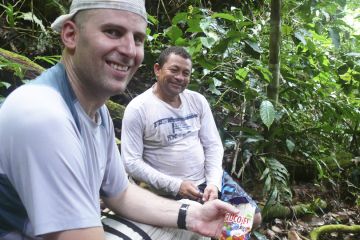
I thought the jungle programme was excellent as were the guides. The itinerary was challenging on some days (in part because I arrived late), however the guides were helpful, able to adjust the pace as necessary.
I probably would have enjoyed being a bit more involved in the hunting/fishing and I think it could have enhance the overall programme if we had ‘lived off the land’ a little more. That said, the meals were a good size and for the most part quite good. A bit more time on the survival aspect would have been good too, although once I asked, Branco and Jose made an effort to point out plants etc......
Overall, Gean, Branco and Jose did an outstanding job!
Highlights: The climb, the anaconda, night hunting and Branco’s fish stew (absolutely brilliant).
Lowlights: The village, the mosquitos.
Cheers,
Ofer Karliner
Lynn Strawbridge and Kerry Pucket
It was truly the trip of a life time. Bronco is an AMAZING person, he made the trip!!!!!!!! Our porters were FABULOUS!!!!! They made us benches, a shelf for our bags, grass skirts, bracelets... they took such good care of us it was truly unbelievable. Waldir was nice as well. Honestly, I can't express how amazing the trip was. It was truly a dream. THANKS to "Amazon Travel Brazil" for giving us this wonderful experience !
Thank you,
Keri and Lynn
continue to the prices & travel dates
prices & dates
Prices & Travel Dates
Rio Negro Rainforest Experience
| Prices | ||
|---|---|---|
| 4 participants | 4,990 US$ | p.p. |
| 3 participants | 5,490 US$ | p.p. |
| 2 participants | 5,900 US$ | p.p. |
| The group will be closed 60 days prior travel date, when the final price depending on the number of participants will be informed and resulting reductions in price will be reimbursed. Price for individual travel on request. | ||
| Travel Time | ||
| 11 days / 10 nights | ||
| Travel Dates | ||
| Please contact Peter for actual travel dates. | ||
Note: Price valid as from/to Manaus
Included
- All transfers
- 1 overnight/breakfast in São Gabriel da Cachoeira
- City hike and stroll in São Gabriel da Cachoeira
- Expedition equipment, canoe, engines, gasoline, hammocks
- Meals
- Guides, carriers
- Permits to enter Indian territories and reservations
- English or English speaking expedition leader
Not included
- International and domestic flights (Manaus-São Gabriel da Cachoeira v.v. 540 US$)
- Alcoholic beverages
- Gratuities
All necessary documents will be delivered by courier.
Payment and reservations
Reservations must be made with a minimum of 90 days prior to departure. To confirm reservations we require a deposit of 30% . The rest is payable within 30 days prior departure.
Best time to travel
This tour is operated from January through December.
Remarks
The hike uphill to the Bela Adormecide mountain requires certain fitness. If you are used to jogg or to hike regularly, than you are in the ideal shape for this adventure.
All participants are expected to coop with each other and to follow instructions given by the leader.
As temperatures vary from permanently well over 30°C during the day, down to around 10°C at night with humidity reaching 90% and more, clothing should include two set search of shorts, shirts with long sleeve, light cotton socks, swim wear, several sets of t-shirts and underwear, rain cape, warm clothing for the night. High leather bootlegs with corrugated sole and solid grip are recommended for hiking and solid rubber trekking sandals to ford or bath in creeks, streams...
Equipment
2 backpacks (70-100 / 35-50 l) as main baggage is stored in São Gabriel, sleeping bag, thermo-flask, binocular, photo equipment, flash light, Swiss army knife, personal cutlery, hut, sunglasses, insect repellent.
Only personal belongings (5-8 kg) have to be carried by each participant
Accomodation
Pousada in São Gabriel da Cachoeira, on expedition in prepared camps and hammocks.
Health
Vaccines mandatory: yellow fever, hepatitis, tetanus
Vaccines not mandatory: malaria prophylaxis
Drinking water
From creeks and rapids, using of disinfection products recommended
First aid
Granted by guides, bring your personal medicine
Communication
Global Star satellite telephone
Meals
Salted, smoked and canned meat , fresh fish, ready made soups,rice, pasta, dehydrated vegetables, crackers, cookies, biscuits, banana and guava sweets, coffee, tea, dry milk
